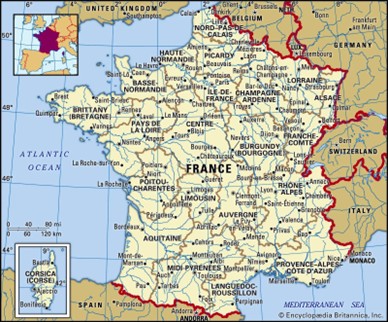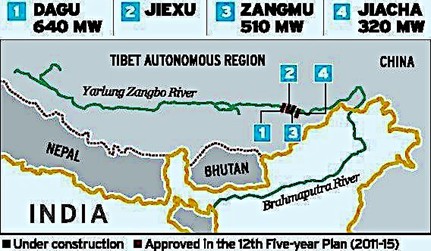Content:
- Shared understandingProject Asiatic Lion
- The problematic globalisation of medical education
- China’s dam project opens the floodgates of concern
Shared understanding
Context : Strengthening Bilateral Relations between France and India .
- Frequent Engagement: Sixth visit by PM Modi to France; Macron has visited India thrice, indicating strong diplomatic engagement.
Relevance : GS 2(International Relations)
Practice Question : Examine the strategic significance of India-France relations in the current geopolitical landscape. How does their partnership balance relations with major global powers? (250 words)

- Defence Cooperation:
- Deals on missiles, helicopters, and jet engines reviewed.
- India offered Indian-made rocket launchers to France.
- Nuclear Cooperation:
- Agreement to develop small modular reactors post-amendments to India’s nuclear liability laws.
- Progress on long-stalled civil nuclear deal.
- Trade and Investment:
- AI Action Summit co-chaired to enhance tech collaboration.
- Visit to a thermonuclear reactor project and a shipping company reflects economic and industrial synergy.
Geopolitical Significance and Strategic Positioning
- Multilateral Engagements:
- Discussion on global conflicts (Ukraine and Gaza) and regional stability.
- Commitment to the India-Middle East-Europe Economic Corridor (IMEC), emphasizing connectivity and economic integration.
- India-France as Independent Powers:
- Macron referred to both as “two great powers” with strategic autonomy.
- Both seek stronger ties with the U.S. and China but aim to avoid overdependence.
- France’s Critique of U.S. Policies:
- Macron criticized U.S. policy on Gaza, calling for a humanitarian approach instead of a “real-estate operation”.
- Discontent with Trump’s unilateralism, especially in dealing with Russia and China.
Global Implications and Future Trajectory
- AI and Climate Change: Discussions on regulating AI risks and addressing climate-related trade disruptions.
- Navigating U.S. Relations:
- Both leaders cautious about Trump’s unpredictability regarding tariffs and foreign policies.
- Potential for deeper Indo-French dialogue on countering unilateral U.S. actions.
- India-France Convergence:
- Increasing alignment in multilateral order and global governance.
- Likely expansion of defence and economic partnerships.
The problematic globalisation of medical education
Overview of Global Medical Education Trends
- Medical education is experiencing a paradox—there is a global shortage of doctors, yet many barriers exist to expanding access to medical studies.
- Governments and medical professionals in many countries resist increasing admissions despite the growing demand.
Relevance : GS 2(Health , Governance , International Relations)
Practice Question : Examine the factors driving the international mobility of medical students. Discuss the challenges and policy concerns associated with the globalisation of medical education. (250 words)
- This has led to a rise in international mobility, with students from various economic backgrounds seeking medical education abroad.
- While once globally interconnected, medical education is now nationally regulated yet increasingly internationalized.
Scale of International Medical Education
- No precise global data exists, but estimates suggest over 2,00,000 students are studying medicine outside their home countries.
- Many of these students enroll in institutions with questionable quality standards.
- Ukraine (pre-war) had 24,000 international medical students, largely from India.
The India Crisis: A Case Study
High Demand and Intense Competition
- India faces a severe shortage of doctors but has limited medical seats.
- 2.3 million students take the national entrance exam annually, with only 1 in 22 gaining admission.
- This intense competition forces students to look for affordable alternatives abroad.
Preferred Destinations for Indian Students
- Indian students study in Russia, Ukraine (pre–war), Kazakhstan, China, the Philippines, Mauritius, and Nepal.
- Some foreign institutions are even owned by Indian education groups, e.g.:
- Manipal College of Medical Sciences, Nepal (run by Manipal Education & Medical Group).
- American University of Antigua (AUA), Caribbean (a division of Manipal).
Challenges Faced by Indian Students Abroad
- Graduates from foreign institutions must pass the national licensing exam to practice in India.
- A mandatory internship is required upon return.
- Many Indian doctors also seek opportunities abroad, facing additional licensing hurdles in those countries.
Government Response and Recent Initiatives : Union Budget 2025:
- 1.1 lakh additional medical seats introduced in the past decade (130% increase).
- 10,000 more seats to be added in 2026.
- Aims to add 75,000 seats over five years to address the demand for doctors.
The Global Nature of the Issue
Not Limited to the Global South
- Medical education shortages exist in Western nations as well.
- Students from France, Germany, the Netherlands, Norway study in Romania, Hungary, and Poland due to lack of seats at home.
- U.S. students pursue medical education in Poland, Hungary, Ireland, the Caribbean, and the UK.
Unregulated Expansion of Medical Schools
- Private, for-profit institutions cater largely to international students.
- Many schools in Central & Eastern Europe, Central Asia, and the Caribbean offer English-medium medical degrees.
- Some governments, like Norway, fund scholarships for students to study abroad.
Challenges and Policy Concerns
Balancing Demand and Quality
- Expansion of medical education is costly and faces resistance from medical establishments.
- There is a global lack of quality control in foreign medical education.
- Medical professionals fear that deregulation may reduce elite status and privileges.
The Way Forward
- Governments need to focus on expanding domestic medical education infrastructure.
- Stricter regulations and accreditation of international medical institutions are necessary.
- Harmonization of licensing exams across countries can ease mobility for doctors while maintaining quality.
China’s dam project opens the floodgates of concern
Context : China is planning a massive hydroelectric dam on the lower section of the upper stream of Yarlung Zangbo in Tibet.
Relevance : GS 2 (International Relations )
Practice Question : Analyze the implications of China’s hydroelectric dam on the Yarlung Zangbo for India, focusing on environmental, legal, and geopolitical concerns. Suggest measures India can take to safeguard its water security. (250 words)
- The river, called Brahmaputra in India, is a crucial water source for northeastern India and Bangladesh.

- The project is part of China’s 14th Five-Year Plan (2021–2025) to transition to renewable energy and achieve carbon neutrality by 2060.
- However, large-scale hydroelectric projects pose risks related to water security, ecology, and geopolitics.
Legal Issues and India’s Vulnerability
- UN Watercourses Convention (1997) mandates equitable use, prevention of harm, and cooperation, but India and China are not signatories.
- China claims to follow four principles:
- International cooperation
- People orientation
- Shared rights and obligations
- Equal focus on development and protection
- However, lower riparian states (India, Bangladesh) suspect China of using water as a strategic tool.
- India depends on Tibet-origin rivers for one-third of its freshwater supply, making it vulnerable to China’s unilateral actions.
- MoUs on Sutlej and Brahmaputra water-sharing have expired, but diplomatic engagements could lead to their renewal.
Environmental Risks
- Tibet is seismically active – past earthquakes (e.g., January 2025, Tibet) caused major casualties.
- Dams disrupt ecosystems by:
- Altering sediment flow, affecting agriculture and fisheries downstream.
- Threatening biodiversity and aquatic species.
- Increasing riverbank erosion, worsening flood risks.
- Bangladesh, though affected, has not opposed the project due to political tensions with India after the fall of Sheikh Hasina’s government (August 2024) and growing ties with China.
Regional Challenges in Water Diplomacy
- Other lower riparian states (Nepal, Bhutan, Pakistan) are also impacted.
- Lack of a regional water alliance makes negotiation difficult.
- South Asia lacks a strong regional body for managing transboundary rivers.
- Political relations between India and its neighbors are volatile, hindering collective action.
Way Forward: Diplomacy & Regional Cooperation
- The Expert Level Mechanism (ELM) provides a structured dialogue platform for India and China.
- Renewing expired MoUs on water-sharing can enhance trust and transparency.
- China reassures India that the dam will not reduce water flow, but India remains skeptical.
- A regional water negotiation framework is necessary to mitigate risks and promote fair water-sharing.



